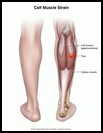
Calf Strain: Teen Version
What is a calf strain?
A strain is a stretch or tear of a muscle or tendon. People commonly call such an injury a "pulled" muscle. A calf strain is an injury to the muscles and tendons in the back of your leg below your knee.
How does it occur?
A strain of your calf muscles can occur during a physical activity where you push off forcefully from your toes. It may occur in running, jumping, or lunging.
What are the symptoms?
A calf muscle strain may cause immediate pain in the back of your lower leg. You may hear or feel a pop or a snap.
You may get the feeling that someone has hit you in the back of the leg. It is hard to rise up on your toes. Your calf may be swollen and bruised.
How is it diagnosed?
Your healthcare provider will examine your lower leg. Your calf muscles will be tender.
How is it treated?
To treat this condition:
- Put an ice pack, gel pack, or package of frozen vegetables, wrapped in a cloth on the area every 3 to 4 hours, for up to 20 minutes at a time.
- You could also do ice massage. To do this, first freeze water in a Styrofoam cup, then peel the top of the cup away to expose the ice. Hold the bottom of the cup and rub the ice over the calf for 5 to 10 minutes. Do this several times a day while you have pain.
- Raise your leg on a pillow when you sit or lie down.
- Use an elastic bandage around your calf as directed by your provider.
- Use crutches, if it is too painful to walk.
- Take an anti-inflammatory medicine such as ibuprofen, or other medicine as directed by your provider. Nonsteroidal anti-inflammatory medicines (NSAIDs) may cause stomach bleeding and other problems. These risks increase with age. Read the label and take as directed. Unless recommended by your healthcare provider, do not take for more than 10 days.
- You may have physical therapy, which may include treatment of the muscle tissue by a therapist using ultrasound or muscle stimulation.
- Your healthcare provider or therapist may tape the injured muscles while they are healing to help you to return to athletic activities.
- Follow your provider’s instructions for doing exercises to help you recover.
- After you recover from your acute injury, use moist heat for 10 to 15 minutes at a time before you do warm-up and stretching exercises. Do not use heat if you have swelling.
While you are recovering from your injury, you will need to change your sport or activity to one that does not make your condition worse. For example, you may need to swim instead of run.
How long will the effects last?
The length of recovery depends on many factors such as your age, health, and if you have had a previous calf injury. Recovery time also depends on the severity of the injury. A mild calf strain may recover within a few weeks, whereas a severe injury may take 6 weeks or longer to recover. You need to stop doing the activities that cause pain until the muscle has healed. If you continue doing activities that cause pain, your symptoms will return and it will take longer to recover.
When can I return to my normal activities?
Everyone recovers from an injury at a different rate. Return to your activities depends on how soon your calf recovers, not by how many days or weeks it has been since your injury has occurred. In general, the longer you have symptoms before you start treatment, the longer it will take to get better. The goal of rehabilitation is to return you to your normal activities as soon as is safely possible. If you return too soon you may worsen your injury.
You may safely return to your activities when, starting from the top of the list and progressing to the end, each of the following is true:
- You have full range of motion in the injured leg compared to the uninjured leg.
- You have full strength of the injured leg compared to the uninjured leg.
- You can walk straight ahead without pain or limping.
How can calf strains be prevented?
Calf strains are best prevented by warming up properly and doing calf-stretching exercises before your activity. This is especially important if you are doing jumping or sprinting sports.

